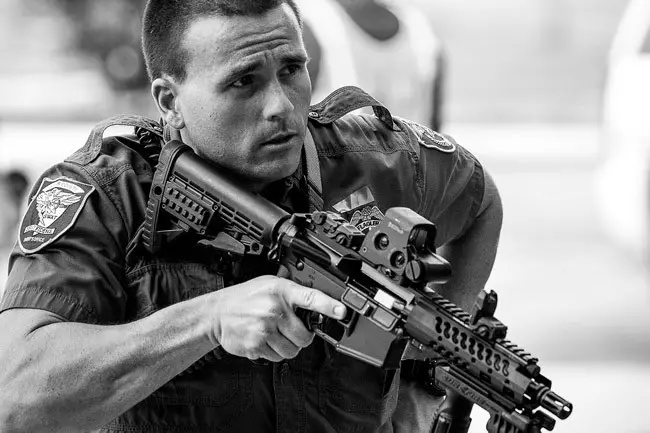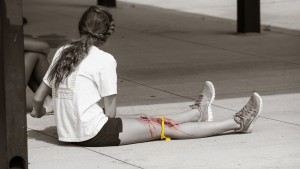
Last Updated: 7:54 p.m.
This was the scenario for this morning’s large-scale emergency-response training exercise at Flagler Palm Coast High School: a man had been in court for a child custody case. The judge ruled that his wife, Sandra Levering, would have sole custody.
At 9 a.m., the woman calls FPC. “This is Sandra Levering,” she tells the receptionist. “My husband and I just finalized a divorce at the courthouse about 10 minutes ago. He lost all parental custody of our two children, Dave Jr. and Samantha.” Levering then relays what her ex-husband said in court: “If I can’t see my kids, then no one can see my kids.” And she tells the receptionist: “I’m afraid that he may come to the school and try to check the children out of class.”
Problem: FPC staff cannot enforce a custody order without a physical copy of that order. But “they should recognize the suspect upon his arrival,” the training scenario states.
There were no children in school today, of course, other than the 100-odd students who volunteered for the exercise, reporting to the school cafeteria at 7 a.m. for make-up and instructions. But later that morning, the man drives onto campus. (The scenario is not clear as to how he’d have gotten on campus, though parents routinely make it in merely by identifying themselves as such at the guard gate.) He gets out fully armed and walks into the school. From that point on, the timelines on the scenarios do not match those of the action at school, with more than a half hour’s delay between the two.
The shooting starts. The 911 center gets a spike of calls with students and teachers begging for help, indicating that a number of people have been shot and providing scant description of the assailant, other than that he’s white. Not much later, frantic parents begin to call. “There is nothing online, nothing on the news yet,” the parent tells the 911 operator, according to the script. “I don’t know how to work Twitter. I am really scared. Please help me. Please tell me what’s happening.”
“I am going to drive to the school to look for him,” another caller says, reflecting a normal impulse authorities deal with in similar situations. “Who did this? Why is this happening? This is not supposed to happen in a community like this. Please give me some answers!” The script even has the Chamber of Commerce’s Rich Stanfield calling and asking for an explanation of the activity at the school. The chamber’s offices are across the street.
Unified Command, the scenario states, “should help craft messaging to address rumor control and limit run away news stories.”
By the end of the shooting spree, seven people have been killed, 39 are wounded (at one point 24 students with minor injuries are bused to Florida Hospital Flagler) and the shooter himself—played by a man who retired from the Department of Homeland Security—is dead. As Winnie Oden, the school district’s director of safety, who was on campus this morning, put it, “the shooter is out of play, he took himself out.”
Much of the theoretical mayhem is contained to the 700 building, though there’s a dead man (a dummy the fire department uses for training, one of several used for the fatalities: no students were put in a position to play fatalities) in the school lobby, and at least two wounded students outside the media center.
The largest exercise of its kind in at least 10 years, for an incident no one wants to ever see.
The scene develops starting at about 9:30 a.m. (it started about 15 minutes later than planned). The shooter is “secured” by 9:54. The rest is a matter of “clearing” the school building by building, securing all students, some of whom are spread out in various buildings, triaging the wounded on various colored mats by the side of the school (the colors denominate degrees of gravity), transporting them by ambulance or by one of the three helicopters taking part in the exercise. (In reality, no students were flown, on order of authorities, to minimize potentially real injuries.)
Flagler’s first responders began preparing for today’s exercise in January, at the direction of Kevin Guthrie, the director of emergency management who’s put a premium on training since he took over that position in late 2013.
“This is the first time in the last nine and a half years, that I know of,” Guthrie said, “that an exercise of this level and this magnitude has been conducted in the county.” Eighteen agencies took part, including from agencies in St. Johns, Putnam, Volusia, the Department of Children and Families, and the Florida Department of Law Enforcement. About 200 people were involved.
“This exercise,” Sheriff Jim Manfre said at a brief news conference organized along Bulldog Drive at the end of the event, “is not in response to any specific threats. We have a safe community, there is no specific threats to our schools or to any of our infrastructure here. Yet what we want to do is be prepared.”
The point of the exercise was to train all those involved, but also to expose vulnerabilities in the system. The objectives of the exercise are extensive and are intended to evaluate about 15 major response capabilities, from the incident command’s ability to properly assign responding personnel to the dispatch or 911 center’s ability to handle the expected calls to responder’s ability to properly preserve rather than corrupt the crime scene to the local hospital’s ability to communicate with emergency responders, or its emergency department’s ability to handle the rush of casualties, and so on. (Curiously, the list of objectives and evaluations targets various responders and the 911 system, but not the Sheriff’s Office’s personnel at the scene, so aside from the dispatch center, how the Sheriff’s Office operated in the emergency will not be part of the after-action report.)

But that may also have been part of the training plan: had the school been locked down, the shooter would have had fewer targets but the exercise might have missed its mark. What’s certain, according to the scenario and the way events unfolded, is that the man made his threats in court at 8:50, and Code Red was not declared on campus until 9:25.
Officials will develop an after-action report that analyzes the exercise thoroughly. The report will be based on the observations of independent evaluators, none of whom is based on Flagler County. The report may not be ready for another month, Guthrie said.
Florida Hospital Flagler was also involved in the exercise. It was the only hospital lined up to take theoretical patients, although in an actual crisis the hospital would be only one of several where patients would be distributed, since it does not have the capacity to handle as large an event as a mass shooting. In the event, the hospital set up a hotline number that would be available for parents to call to get information on victims.
The scenario had its quirks. After the shooter arrived, Calvin Grant, the Flagler County Sheriff’s deputy and a school resource officer, was actually first on scene for the exercise (he was not on campus beforehand), walked in with his gun drawn, and, off script, managed to shoot the assailant: in essence, Grant theoretically had put an end to the crisis before it started. But the exercise had to unfold. So Grant was “killed” instead, and the assailant resumed his rampage.
Guthrie was asked in late afternoon for a brief assessment of the morning, beyond the back-patting. “Right now from the way I see things I think we need to work on our internal and external communications. That’s something we’re going to meet on,” he said. By which he means getting cops to talk to fire personnel, getting responders to talk to talk to school board members, working on external communications with stakeholders, whether it’s nearby businesses or beyond. “It’s “always an area we can always can improve on,” he said.
Second, he said inter-agency coordination and cooperation can improve. “We’ve been working on it very diligently for the last 20 months, we saw it come together a little bit today, but we still have room for it to continue to come together,” Guthrie said, though for that, more training opportunities are needed. “What we’re trying to do is build the relationships between fire and law enforcement and the school board.”
Third, there’s still a greater need for public-private partnerships that can help with numerous secondary developments beyond the crisis point, whether it’s providing crisis counselors or providing a place for parental reunification with children.
Overall, Guthrie said the day did not yield “glaring” vulnerabilities. But he noted that the community should not focus on the training incident as one exclusively related to an assailant on a campus. The same scenario could be applied to a train derailment in the county, to a large traffic pile-up on the Interstate or to any incident that would require the response of numerous agencies.
And even Guthrie’s assessment was rosier than more candid conclusions from responders lower down the ranks, who spoke of serious communication failures inside the school, between ground officials and the pilots of some helicopters, and between sheriff’s and fire department commanders, strongly suggesting that just as the messaging filtered to public information officers was controlled and massaged, the official back-patting at the end of the morning, from top officials, was itself a sweetened version of the exercise. The degree of realism, meanwhile, had to be tempered with certain realities: only a dozen or so deputies took part in the exercise, a very unlikely number in the event of such an emergency.
Much of the exercise was out of view of reporters, who were invited to watch, film and photograph various segments of the theoretical incident from different but limited vantage points. They were not taken into the guts of the rampage. In an actual crisis reporters would not be permitted on campus but would, as the script indicate, be pressuring officials for information and interviews. The script emphasizes a “unified” approach to the release and control of information through the filter of public information officers.
“It was an awesome exercise,” Oden, the school district’s safety director, said. “I’ve worked with these guys for years, doing policies and manuals and talking, but today I got to see everybody in their game face. It was to be honest very comforting that everybody knows what to do, what to do when they get here. The goal really for all the participating agencies, at least in my perspective, was to find out if we still have challenges, what do we need to tighten up, what needs to be looked at or what better communication do we need. In the field of education you always have an opportunity to improve so we’re all going to get together and have those discussions.”
Several businesses contributed food, water and other services to the effort, including meals for all the evaluators from Woody’s BBQ, donuts for all participants from the Dunkin Donuts on State Road 100, gift vouchers for all the student participants from Chick-fil-A, videography and other services from Stratus Photo, and water and gift cards from Publix and Winn-Dixie, and water from Home Depot and CVS.




























Lancer says
Well done. Every school in Flagler County needs to conduct this exercise, at least, once a year. Training in handling and preventing this type of scenario is invaluable.
People who do this type of thing are always looking for “soft targets” with little or no resistance.